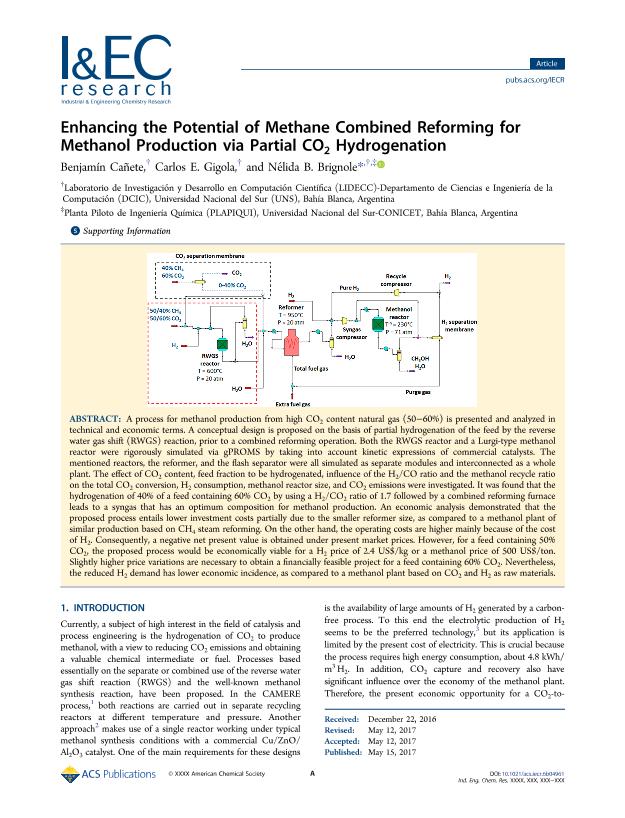Artículo
Enhancing the Potential of Methane Combined Reforming for Methanol Production via Partial CO 2 Hydrogenation
Fecha de publicación:
15/05/2017
Editorial:
American Chemical Society
Revista:
Industrial & Engineering Chemical Research
ISSN:
0888-5885
Idioma:
Inglés
Tipo de recurso:
Artículo publicado
Clasificación temática:
Resumen
(Figure Presented) A process for methanol production from high CO2 content natural gas (50-60%) is presented and analyzed in technical and economic terms. A conceptual design is proposed on the basis of partial hydrogenation of the feed by the reverse water gas shift (RWGS) reaction, prior to a combined reforming operation. Both the RWGS reactor and a Lurgi-type methanol reactor were rigorously simulated via gPROMS by taking into account kinetic expressions of commercial catalysts. The mentioned reactors, the reformer, and the flash separator were all simulated as separate modules and interconnected as a whole plant. The effect of CO2 content, feed fraction to be hydrogenated, influence of the H2/CO ratio and the methanol recycle ratio on the total CO2 conversion, H2 consumption, methanol reactor size, and CO2 emissions were investigated. It was found that the hydrogenation of 40% of a feed containing 60% CO2 by using a H2/CO2 ratio of 1.7 followed by a combined reforming furnace leads to a syngas that has an optimum composition for methanol production. An economic analysis demonstrated that the proposed process entails lower investment costs partially due to the smaller reformer size, as compared to a methanol plant of similar production based on CH4 steam reforming. On the other hand, the operating costs are higher mainly because of the cost of H2. Consequently, a negative net present value is obtained under present market prices. However, for a feed containing 50% CO2, the proposed process would be economically viable for a H2 price of 2.4 US$/kg or a methanol price of 500 US$/ton. Slightly higher price variations are necessary to obtain a financially feasible project for a feed containing 60% CO2. Nevertheless, the reduced H2 demand has lower economic incidence, as compared to a methanol plant based on CO2 and H2 as raw materials.
Palabras clave:
Co2 Utilization
,
Rwgs
,
Combined Reforming
,
Methanol
,
Npv Analysis
Archivos asociados
Licencia
Identificadores
Colecciones
Articulos(PLAPIQUI)
Articulos de PLANTA PILOTO DE INGENIERIA QUIMICA (I)
Articulos de PLANTA PILOTO DE INGENIERIA QUIMICA (I)
Citación
Cañete, Benjamin; Gigola, Carlos Eugenio; Brignole, Nélida Beatriz; Enhancing the Potential of Methane Combined Reforming for Methanol Production via Partial CO 2 Hydrogenation; American Chemical Society; Industrial & Engineering Chemical Research; 56; 22; 15-5-2017; 6480-6492
Compartir
Altmétricas




